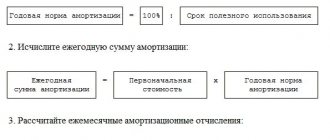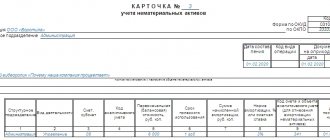Company property that is used in its activities, but does not have a tangible form, is classified as intangible assets (IMA). This term denotes acquired and created results of intellectual work (inventions, industrial designs and models, trademarks and brands, new technologies, formulas and processes, etc.) and exclusive rights to them. Such assets must be used in production or implementation of management needs for a long time (more than 12 months). PBU 14/07 gives the concept of intangible assets and the criteria for their use in the accounting of a company, and Articles 257 and 258 of the Tax Code of the Russian Federation determine the rules of tax accounting.
A company's website also falls into the category of intangible assets if the company has exclusive rights to it, its use brings benefits to the company, and the planned operation exceeds 12 months. Let's consider the issue of assigning a depreciation group and the criteria that the company must follow in this process.
Let's understand the terminology
Paragraphs 13 and 15 of Article 2 of the Federal Law of July 27, 2006 No. 149-FZ “On Information, Information Technologies and Information Protection” state:
- website on the Internet - a set of programs for electronic computers and other information contained in an information system, access to which is provided through the Internet information and telecommunications network using domain names and (or) network addresses that allow identifying sites on the Internet.
- domain name is a symbol designation intended for addressing sites on the Internet in order to provide access to information posted on the Internet.
In other words, a site is a “place” on the Internet that is defined by its own “address”, has its own owner and consists of web pages that are perceived as a single whole. An Internet site as a collection of visually perceptible pages and controls is created using certain commands and thus is a visual representation of a computer program as a collection of these commands. Therefore, in accordance with Article 1261 of the Civil Code of the Russian Federation, the site can be considered as a computer program.
...a site is a “place” on the Internet that is defined by its own “address”, has its own owner and consists of web pages that are perceived as a single whole...
From the point of view of civil law, a website as a set of computer programs, databases and works of graphics and design is classified as objects of copyright and is subject to legal protection (subclauses 1, 2, 3, clause 1, article 1225, paragraph 7, 13 p 1, paragraph 2, paragraph 2, Article 1259, paragraph 2, Article 1260, Article 1261 of the Civil Code of the Russian Federation). The exclusive right to the result of intellectual activity created by creative work initially arises with its author. In this case, this right can be transferred by him to another person (clause 3 of Article 1228 of the Civil Code of the Russian Federation).
A domain (domain name) is the name (address) of your website on the Internet, which consists of a unique combination of characters (Clause 15, Article 2 of Federal Law No. 149-FZ).
The domain name must be registered with the Russian Research Institute for the Development of Public Networks (RosNIIROS) or with registrars authorized by it. Re-registration of a domain name is carried out, as a rule, annually and provides the organization with the opportunity to retain the specific name of its website on the Internet.
Hosting is a service provided on a regular basis for placing an organization’s website on a provider’s server that is permanently connected to the Internet.
Initial cost
In accounting, the site is accounted for as part of intangible assets at historical cost. It is equal to the sum of all website development costs, which include:
- expenses for services and work of third parties;
- salaries of employees directly involved in the development;
- contributions for compulsory pension (social, medical) insurance and insurance against accidents and occupational diseases;
- expenses for maintaining fixed assets (other property) and intangible assets used to create a new asset, as well as depreciation amounts accrued on them;
- non-refundable taxes and fees;
- government, patent and other similar duties;
- customs duties and fees;
- other similar expenses.
This is stated in paragraphs 8 and 9 of PBU 14/2007.
The initial cost also includes the costs of developing (purchasing) the graphic design of the site (i.e., computer program). Despite the fact that the design of a website is the subject of copyright (paragraph 7, clause 1, article 1259 of the Civil Code of the Russian Federation), it cannot be taken into account as an independent object of intangible assets. This is explained by the fact that website design alone cannot bring economic benefits to the organization. And this is one of the main conditions for recognizing an object as part of intangible assets (subparagraph “a”, paragraph 3 of PBU 14/2007). In addition, the inventory object of intangible assets can be either one right or a set of rights to one object. Such rules are established by paragraphs 5 and 9 of PBU 14/2007.
We reflect the creation of the site in accounting
Accounting for exclusive rights
In accounting, the procedure for accounting for the costs of creating a website depends on whether the organization recognizes its intangible assets or not.
If an organization has acquired exclusive rights to a website or its individual parts that are capable of independently generating income, then in accounting they should be taken into account as part of intangible assets (IMA) when fulfilling the requirements of clause 3 of PBU 14/2007 (approved by Order of the Ministry of Finance of Russia dated December 27 .2007 No. 153n), in particular, if the object is intended for use for a period exceeding 12 months and is capable of bringing economic benefits to the organization.
An intangible asset is accepted for accounting at its actual (initial) cost determined as of the date of its capitalization (clause 6 of PBU 14/2007).
If an organization develops a website independently, then in accounting the initial (actual) cost of the website will be the costs of paying the organization’s employees, as well as the amount of insurance premiums accrued from the wages of employees participating in the creation of intangible assets.
If the development of the site was entrusted to a third-party organization and it transfers exclusive rights to it, then the initial cost of the intangible assets will be the amount of costs for developing the site under an agreement with the developer organization.
Also included in the initial cost of intangible assets are other expenses directly related to the acquisition and creation of an intangible asset and providing conditions for using the asset for the intended purposes (clauses 8 and 9 of PBU 14/2007). For example, the cost of the initial registration of a domain name should be taken into account in the cost of intangible assets. After all, as already mentioned, a website cannot function without a domain name.
...quite often a website is created for an indefinite period, depreciation for such intangible assets is not accrued in accounting...
Looking ahead, we will say that the initial cost of intangible assets will be formed similarly in tax accounting (clause 3 of Article 257 of the Tax Code of the Russian Federation, Letter of the Ministry of Finance of Russia dated 02.02.2011 No. 03-03-06/1/55, dated 03.25.2011 No. 03-03-06/1/173).
The cost of intangible assets is repaid by calculating depreciation over their useful life (clause 23 of PBU 14/2007).
For intangible assets with an indefinite useful life, depreciation is not accrued in accounting (clause 23 of PBU 14/2007).
In this case, the useful life is the period expressed in months during which the organization expects to use intangible assets to obtain economic benefits (clause 25 of PBU 14/2007). It is determined based on (clause 26 PBU 14/2007):
- the validity period of the organization’s rights to the result of intellectual activity and the period of control over the asset;
- the expected life of the asset over which the entity expects to receive economic benefits.
The organization must annually check the useful life and method of calculating depreciation for intangible assets. If the period of use of the site changes significantly and/or if the calculation of the expected flow of future economic benefits from its use changes significantly, the useful life and/or method of determining depreciation should be changed accordingly.
In practice, quite often a website is created for an indefinite period; therefore, its useful life cannot be clearly established; accordingly, depreciation for such intangible assets is not accrued in accounting. But every year the organization must consider the presence of factors indicating the impossibility of reliably determining the useful life of a given asset (clause 27 of PBU 14/02007). And in case of termination of their existence, i.e. after the emergence of data on the period of use of the site, intangible assets can be depreciated.
In this case, as well as in the case of revision of the useful life of intangible assets, the resulting adjustments are reflected in accounting and financial statements as changes in estimated values (clauses 27, 30 PBU 14/2007, clauses 2, 3, 4 of the Accounting Regulations “ Changes in estimated values" (PBU 21/2008), approved by Order of the Ministry of Finance of Russia dated October 6, 2008 No. 106n.).
In accounting, costs associated with the acquisition of objects that will subsequently be accepted for accounting as intangible assets are taken into account in account 08 “Investments in non-current assets”, subaccount “Acquisition of intangible assets”. The generated actual (initial) value of intangible assets is written off from account 08 to the debit of account 04 “Intangible assets”.
Depreciation is reflected in the credit of account 05 “Amortization of intangible assets” and the debit of cost accounting accounts 20, 26, 44, etc.
Tax accounting of intangible assets
In tax accounting, the conditions for recognizing intangible assets are almost the same as in accounting.
However, in tax accounting, unlike accounting, a restrictive criterion is provided for recognizing an object as depreciable property: the initial cost of the object must be at least 40,000 rubles (clause 1 of Article 256 of the Tax Code of the Russian Federation, Letter of the Federal Tax Service of the Russian Federation dated November 24, 2011 No. ED -4-3/19695).
According to the Ministry of Finance of Russia, if the costs of creating a website amounted to an amount less than the cost of depreciable property (less than 40,000 rubles) (clause 1 of Article 256 of the Tax Code of the Russian Federation), then such a site is not recognized as an intangible asset, and the costs for it are written off at a time the composition of other expenses associated with production and sales (clause 1 of Article 256 of the Tax Code of the Russian Federation).
For your information
The site can be used in activities aimed at generating income, but does not meet the criteria for intangible assets. This occurs in the following situations
• useful life is less than 12 months (Letter of the Ministry of Finance of the Russian Federation dated July 21, 2010 No. 03-03-06/1/480); • the organization received exclusive rights only to certain elements of the site that cannot function independently, for example, only to the site design.
In these cases, the costs are taken into account as other expenses:
• as expenses for the acquisition of computer programs and databases under contracts with the copyright holder (clause 26 of article 264 of the Tax Code of the Russian Federation); • or as periodic payments under a license agreement for the use of rights to the results of intellectual activity (subclause 37, clause 1, article 264 of the Tax Code of the Russian Federation); • or as other expenses associated with the acquisition or creation of a website (subclause 49, clause 1, article 264 of the Tax Code of the Russian Federation).
If advertising information is posted on the site, then these costs are taken into account as advertising expenses (subclause 28, clause 1, article 264 of the Tax Code of the Russian Federation).
Intangible assets are classified as depreciable property (Clause 1, Article 256 of the Tax Code of the Russian Federation).
The organization begins to calculate depreciation on the 1st day of the month following the month in which the site was put into operation (clause 2 of Article 259 of the Tax Code of the Russian Federation). In this case, the commissioning date is the moment the site is posted on the Internet.
The useful life of an intangible asset is determined based on the validity period of the patent, certificate and (or) other restrictions on the period of use of intellectual property objects, as well as on the basis of the period stipulated by the relevant contracts.
If the useful life cannot be determined, depreciation rates are established based on a useful life equal to ten years, but not more than the period of activity of the taxpayer (clause 2 of Article 258 of the Tax Code of the Russian Federation).
However, there is a special rule for computer programs and databases. For such objects, the taxpayer can establish the useful life independently, but this period cannot be less than two years (clause 2 of Article 258 of the Tax Code of the Russian Federation).
If there are no exclusive rights to the site
If the exclusive rights to the site are not transferred, then in this case the organization receives intangible assets for use and such rights are taken into account on an off-balance sheet account in an assessment determined based on the amount of remuneration established in the agreement.
In this case, payments for the granted right to use the results of intellectual activity, made in the form of a one-time payment, are reflected in accounting as deferred expenses in account 97 “Deferred expenses” and are subject to write-off as expenses for ordinary activities of the current period during the validity period of the license agreement (paragraph 2, clause 39 PBU 14/2007, clause 65 of the Regulations on accounting and financial reporting in the Russian Federation, clauses 5, 7, 19 of the Accounting Regulations “Expenses of the organization” PBU 10/99, approved by the Order Ministry of Finance of Russia dated May 6, 1999 No. 33n).
Periodic payments, calculated and paid in the manner and within the terms established by the agreement, are included in the expenses of the reporting period (paragraph 2, paragraph 39 of PBU 14/2007, paragraphs 5, 7, 16, 18 of PBU 10/99). These expenses are reflected in the debit of cost accounting accounts 20, 26, 44, etc. in correspondence with the credit of the account of settlements with the copyright holder (account 76) (Instructions for using the Chart of Accounts).
In tax accounting, if there are no exclusive rights to a website, the costs of its creation will be taken into account as part of other expenses associated with production and sales (subclause 26, clause 1, article 264 of the Tax Code of the Russian Federation). The Russian Ministry of Finance believes that these expenses should not be taken into account at the same time. When applying the accrual method, they are written off in the following order (Letter dated August 31, 2012 No. 03-03-06/2/95):
- if, under the terms of the agreement for the acquisition of non-exclusive rights, a period for using computer programs is established, expenses related to several reporting periods are taken into account when calculating the tax base evenly over these periods;
- if the terms of the agreement for the acquisition of non-exclusive rights cannot determine the period of use of computer programs, then the expenses incurred are distributed taking into account the principle of uniform recognition of income and expenses. In this case, the taxpayer in tax accounting has the right to independently determine the period during which these expenses are subject to accounting for profit tax purposes.
Exclusive and non-exclusive rights
Computer programs are subject to copyright (Clause 1, Article 1259 of the Civil Code of the Russian Federation). Therefore, the procedure for reflecting the costs of creating a website in accounting depends on what rights the organization owns to it - exclusive or non-exclusive.
If an organization has exclusive rights to a website, developers do not have the right to create the same website for other persons. That is, the site is unique, and the organization becomes its sole owner.
If the organization has non-exclusive rights to the site, developers can create a similar site for other persons (clause 1 of Article 1297 and subclause 1 of clause 1 of Article 1236 of the Civil Code of the Russian Federation).
If the site is created on its own, then the exclusive rights to it may belong to the organization in the following cases:
- if the employment or other agreement with the employee involved in the development of the site does not provide for the retention of all exclusive rights to the site (Article 1261, paragraph 2 of Article 1295 of the Civil Code of the Russian Federation);
- if the author's order agreement with a third-party specialist does not stipulate that the exclusive rights to the site belong to the contractor (clauses 1 and 3 of Article 1296 of the Civil Code of the Russian Federation);
- if the contract or R&D agreement, which does not directly imply the creation of a website, stipulates that exclusive rights to the website belong to the customer organization (Clause 1 of Article 1297 of the Civil Code of the Russian Federation).
Website domain name registration, technical support and hosting services
As we have already said, in accounting and tax accounting, the cost of the initial registration of a domain name can be taken into account in the cost of intangible assets, since without it the site cannot be used to create it.
Expenses for re-registration of a domain name are recorded in account 97 “Deferred expenses” and are written off in accounting and tax accounting evenly over the period for which it is extended. If such a period is not specified, expenses are taken into account at a time (clause 65 of the Regulations on accounting and reporting in the Russian Federation, subclause 49, clause 1, article 264 of the Tax Code of the Russian Federation, clause 1, article 272 of the Tax Code of the Russian Federation, Letter dated January 17, 2007 No. 20-12/004121).
As for the costs of paying for hosting services and technical support of the site, these types of expenses are reflected in accounting as part of expenses for ordinary activities (clause 5 of PBU 10/99). For the purposes of taxation of profits of this type, expenses are classified as other expenses related to production and sales (subclause 49, clause 1, article 264 of the Tax Code of the Russian Federation). If information is posted on the website for advertising purposes, then these expenses can be taken into account as advertising (subclause 28, clause 1, article 264 of the Tax Code of the Russian Federation, Letter of the Federal Tax Service for Moscow dated January 17, 2007 No. 20-12/004121) .
Rimma Skorohvatova
, tax consultant at the First House of Consulting “What to do Consult”, for the magazine “Moscow Accountant”
Develop professionally
Invaluable experience in solving current problems, answers to complex questions, specially selected latest information in the press for accountants and managers. Choose from our catalog >>
If you have a question, ask it here >>
Practical situation
Initial data
Romashka LLC entered into a contract for the creation of a website with Dandelion LLC. According to the terms of the contract, exclusive rights to the created website belong to the customer. The cost of work under the contract was 500,000 rubles.
Romashka LLC also paid for a domain name in the amount of 10,000 rubles, and hosting services - 15,000 rubles. in a year.
The organization set the useful life of the created website at five years. The site was created for the purpose of online trading.
After the site was accepted for registration, Romashka LLC entered into a fee-for-service agreement. The subject of the agreement was the provision of services to promote the site on the Internet, optimize the site for search engines and bring the site to high positions in search engines (top 10). The cost of services under the paid services agreement amounted to 118,000 rubles, including VAT of 18,000 rubles.
A year after paying for the domain name and hosting services, the organization again paid for these services at the same prices. According to the terms of the organization’s accounting policy, for accounting purposes, the organization takes into account these expenses at a time as part of current expenses (selling expenses, since the site is associated with the company’s trading activities).
What is it regulated by?
- Chapter 25 of the Tax Code of the Russian Federation (the main applied articles are 257, 258, 259);
- Classification of OS (Resolution of the Government of the Russian Federation dated January 1, 2002 No. 1).
Fixed assets in tax accounting are part of the property used as means of labor for the production and sale of goods (performing work, providing services) or for managing an organization with an initial cost of more than 100,000 rubles (Article 257 of the Tax Code of the Russian Federation).
When can website costs be taken into account under the simplified tax system?
To take into account the costs of a website under the simplified tax system, you need to be able to take into account the costs of a special regime. If the simplified tax system “income” is applied, nothing will be taken into account.
Therefore, further we will only talk about accounting for the costs of creating and promoting a website under the simplified tax system “income minus expenses”.
An important condition for accepting a site for registration as intangible assets on the simplified tax system is that the site meets the criteria set out in the letter of the Ministry of Finance dated February 26, 2018 No. 03-11-06/2/11967:
- Intangible assets must be depreciable. It will be necessary to determine the period during which the developed site software will be useful for calculating depreciation;
- The intangible asset (site) must be used in the main commercial activity. Of course, such use must be supported and made explicit. For example, if a company sells pet food, and the director runs a website for fans of vintage cars, it will be difficult to take into account the costs of an “automotive” website.
RESULTS
Purchasing used fixed assets gives the organization a number of advantages, such as:
- the market price of these fixed assets is usually lower than that of new ones;
- The useful life of such fixed assets may be reduced, and, consequently, used fixed assets may be fully depreciated earlier than new ones.
In order to take into account the period of actual operation of the fixed asset by the previous owner, documentary evidence of the specified period is required. The most reliable document for confirmation will be the Certificate of Acceptance and Transfer of an OS Object. In the absence of these documents, there is a likely risk of a dispute with the tax office and litigation. As for accounting for fixed assets, we recommend that both accounting and tax accounting establish the same initial cost, useful life and depreciation methods, which will bring accounting and tax accounting as close as possible.
Read on this topic: Property tax 2013 Property tax 2020 Depreciation bonus as a way to optimize
Firmmaker, November 2014 (updated annually) Svetlana Markina (Mityukhina), Irina Bazyleva When using the material, reference is required





